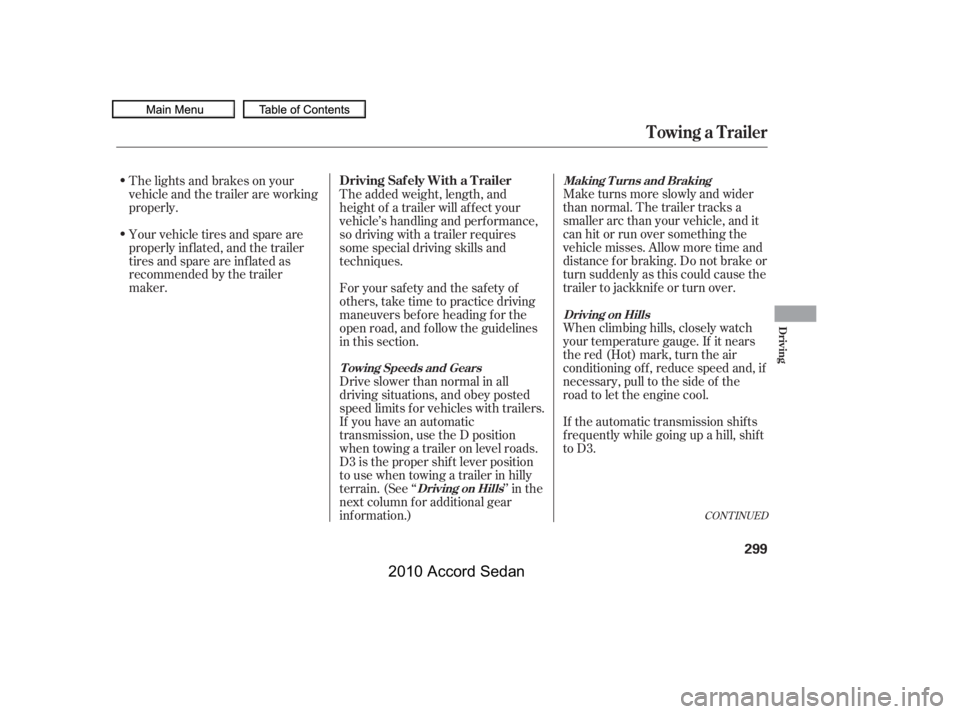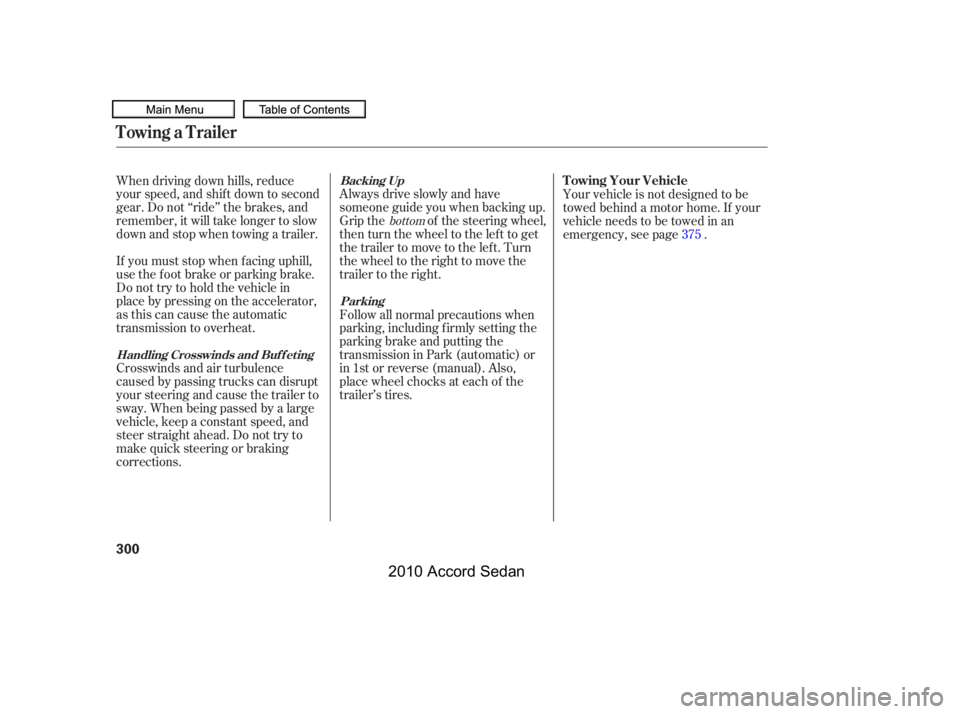Page 302 of 414

Maketurnsmoreslowlyandwider
than normal. The trailer tracks a
smaller arc than your vehicle, and it
canhitorrunoversomethingthe
vehicle misses. Allow more time and
distance f or braking. Do not brake or
turn suddenly as this could cause the
trailer to jackknif e or turn over.
When climbing hills, closely watch
your temperature gauge. If it nears
the red (Hot) mark, turn the air
conditioning of f , reduce speed and, if
necessary, pull to the side of the
road to let the engine cool.
If the automatic transmission shif ts
f requently while going up a hill, shif t
to D3.
The lights and brakes on your
vehicle and the trailer are working
properly.
Your vehicle tires and spare are
properly inf lated, and the trailer
tires and spare are inflated as
recommended by the trailer
maker.
The added weight, length, and
height of a trailer will af f ect your
vehicle’s handling and perf ormance,
so driving with a trailer requires
some special driving skills and
techniques.
Foryoursafetyandthesafetyof
others,taketimetopracticedriving
maneuvers bef ore heading f or the
open road, and f ollow the guidelines
in this section.
Drive slower than normal in all
driving situations, and obey posted
speed limits f or vehicles with trailers.
If you have an automatic
transmission, use the D position
when towing a trailer on level roads.
D3 is the proper shif t lever position
to use when towing a trailer in hilly
terrain. (See ‘‘’’ in the
next column f or additional gear
inf ormation.)CONT INUED
Making T urns and Braking
Driving on Hills
T owing Speeds and Gears
Driving on Hills
Towing a Trailer
Driving Saf ely With a T railer
Driving
299
�����—�����—�
���y�
�������������y���
�)�����������y���������y
2010 Accord Sedan
Page 303 of 414

Always drive slowly and have
someone guide you when backing up.
Grip the of the steering wheel,
then turn the wheel to the left to get
the trailer to move to the lef t. Turn
the wheel to the right to move the
trailer to the right.
When driving down hills, reduce
your speed, and shif t down to second
gear. Do not ‘‘ride’’ the brakes, and
remember, it will take longer to slow
downandstopwhentowingatrailer.
If you must stop when f acing uphill,
use the f oot brake or parking brake.
Do not try to hold the vehicle in
placebypressingontheaccelerator,
as this can cause the automatic
transmission to overheat.
Your vehicle is not designed to be
towed behind a motor home. If your
vehicle needs to be towed in an
emergency, see page .
Crosswinds and air turbulence
caused by passing trucks can disrupt
your steering and cause the trailer to
sway. When being passed by a large
vehicle, keep a constant speed, and
steer straight ahead. Do not try to
make quick steering or braking
corrections.
Follow all normal precautions when
parking, including f irmly setting the
parking brake and putting the
transmission in Park (automatic) or
in 1st or reverse (manual). Also,
place wheel chocks at each of the
trailer’s tires.
375
bottom
Backing Up
Parking
Handling Crosswinds and Buf f et ing
Towing Your Vehicle
Towing a Trailer
300
�����—�����—�
���y�
���������
���y���
�)�����������y���������y
2010 Accord Sedan
Page 304 of 414

This section explains why it is
important to keep your vehicle well
maintained and how to f ollow basic
maintenance saf ety precautions.
This section also includes
instructions on how to read the
maintenance minder messages on
the information display, and
instructions f or simple maintenance
tasks you may want to take care of
yourself .
If you have the skills and tools to
perf orm more complex maintenance
tasks on your vehicle, you may want
to purchase the service manual. See
page f or inf ormation on how to
obtain a copy, or see your dealer.
......................Maintenance Saf ety.302
....................Maintenance Minder .303
..............................Fluid Locations.310
........................Adding Engine Oil.312
Changing the Engine Oil and
...........................................Filter.314
..............................Engine Coolant.316
....................Windshield Washers.318
.......................Transmission Fluid.319
..........Automatic Transmission .319
..............Manual Transmission .321
................Brake and Clutch Fluid .322
................................Brake Fluid.322
...............................Clutch Fluid.323
....................Power Steering Fluid .323
....................................Timing Belt.324
.............................................Lights.325
................Cleaning the Seat Belts .334
.....................................Floor Mats.334
..................Dust and Pollen Filter .335
.................................Wiper Blades.336
...............................................Tires.339
...................Checking the Battery .347
.............................Vehicle Storage.348
399
Maintenance
Maint enance
301
�����—�����—�
���y�
�������������y���
�)�����������y���������y
2010 Accord Sedan
Page 311 of 414

�µ
�µ
�µ
�µ
�µ
�µ
�Ì
Engine oil level Check every
time you fill the fuel tank. See
page .
Engine coolant level Check the
radiator reserve tank every time
you f ill the f uel tank. See page .
Automatic transmission Check
the f luid level monthly. See page
.
Brakes Check the f luid level
monthly. See page .
Tires Check the tire pressure
monthly. Examine the tread f or
wear and foreign objects. See page
.
Lights Check the operation of
the headlights, parking lights,
taillights, high-mount brake light,
and license plate lights monthly.
See page .
Youshouldcheckthefollowing
items at the specif ied intervals. If
you are unsure of how to perf orm
any check, turn to the appropriate
page listed.
U.S. Vehicles:
According to state and federal
regulations, f ailure to perf orm
maintenance on the items marked
with will not void your emissions
warranties. However, all
maintenance services should be
perf ormed in accordance with the
intervals indicated by the
inf ormation display.
However, service at a dealer is not
mandatory to keep your warranties
in effect. Maintenance may be done
by any qualif ied service f acility or
person who is skilled in this type of
automotive service. Make sure to
have the service f acility or person
reset the display as previously
described. Keep all receipts as proof
of completion, and have the person
who does the work f ill out your
Honda Service History or Canadian
Maintenance Log. Check your
warranty booklet f or more
inf ormation.
We recommend using Honda parts
and fluids whenever you have
maintenance done. These are
manuf actured to the same high
quality standards as the original
components, so you can be conf ident
of their perf ormance and durability.
262
263
319
322
339
325
Maintenance Minder
Owner’s Maintenance Checks
Maintenance, replacement, or
repair of emissions control
devices and systems may be done
by any automotive repair
establishment or individual using
parts that are ‘‘certif ied’’ to EPA
standards.
308
�����—�����—�
���y�
�������������y���
�)�����������y�����
���y
2010 Accord Sedan
Page 312 of 414

�Î �Î
�Ì�Ì
�µ�µ�Ì
�Î
Maintenance Minder
309
Maintenance Main ItemsReplace engine oil Replace engine oil and oil filterInspect front and rear brakesCheck parking brake adjustmentInspect these items:Tie rod ends, steering gear box, and bootsSuspension componentsDriveshaft bootsBrake hoses and lines (including ABS/VSA)All fluid levels and condition of fluidsExhaust systemFuel lines and connections
Maintenance Sub ItemsRotate tiresReplace air cleaner element
Replace dust and pollen filter
Inspect drive belt Replace transmission fluidReplace spark plugsReplace timing belt and inspect water pump(V6 engine only)
Inspect valve clearance Replace engine coolant
:
AB
Symbol12
3 4
5
Symbol1 1
Inspect idle speed every 160,000 miles (256,000 km).
Adjust the valves during services A, B, 1, 2, or 3 only if they are noisy.
If the message ‘‘SERVICE’’ does not appear more than 12 months after the display is reset, change the engine oil every year.
Independent of the maintenance messages in the information display,replace the brake fluid every 3 years.
See information on maintenance and emissions warranty in the centercolumn on page .
NOTE:
1:
308
If you drive in dusty conditions, replace every 15,000 miles (24,000 km).
If you drive primarily in urban areas that have high concentrations of soot in the air from industry and fromdiesel-powered vehicles, replace every 15,000 miles(24,000 km).
If you drive regularly in very high temperatures (over 110°F, 43°C), or in very low temperatures (under 20°F,29°C), replace every 60,000 miles (U.S.)/100,000 km(Canada).
Maintenance Minder
�����—�����—�
���y�
�������������y���
�)�����������y�����
���y
2010 Accord Sedan
Page 313 of 414
Fluid Locations
4-cylinder models
310
ENGINE OIL FILL CAP
CLUTCH FLUID (ManualTransmission only)(Light gray cap)
AUTOMATIC TRANSMISSIONFLUID DIPSTICK(Yellow loop)
BRAKE FLUID(Black cap)
ENGINE OIL DIPSTICK (Orange handle)
POWER STEERING FLUID (Red cap)
WASHER FLUID (Blue cap)
RADIATOR CAP
ENGINE COOLANT RESERVOIR
�����—�����—�
���y�
�������������y���
�)�����������y�����
���y
2010 Accord Sedan
Page 314 of 414
Fluid Locations
V6 models
Maint enance
311
ENGINE OIL FILL CAP
BRAKE FLUID (Black cap)
AUTOMATIC TRANSMISSIONFLUID DIPSTICK(Yellow loop)
RADIATOR CAP
ENGINE OIL DIPSTICK (Orange loop)
POWER STEERING FLUID (Red cap)
WASHER FLUID (Blue cap)
ENGINE COOLANT RESERVOIR
�����—�����—�
���y�
�������������y���
�)�����������y�����
���y
2010 Accord Sedan
Page 316 of 414

Honda Motor Oil is the pref erred
5W-20 lubricant f or your vehicle. It is
highly recommended that you use
Honda Motor Oil in your vehicle f or
optimum engine protection. Make
sure the API Certif ication Seal says
‘‘For Gasoline Engines.’’
Your vehicle does not require any oil
additives. Additives may adversely
af f ect the engine or transmission
perf ormance and durability.
The oil viscosity or weight is
provided on the container’s label.
5W-20 oil is f ormulated f or year-
round protection of your vehicle to
improve cold weather starting and
f uel economy.
You may use a synthetic motor oil if
it meets the same requirements
given f or a conventional motor oil: it
displays the API Certif ication Seal,
and it is the proper weight. You must
f ollow the oil and f ilter change
intervals shown on the information
display.
Synthetic Oil
Engine Oil A dditives
A dding Engine Oil
Maint enance
313
API CERTIFICATION SEAL
Ambient Temperature
�����—�����—�
���y�
���������
���y���
�)�����������y�����
���y
2010 Accord Sedan